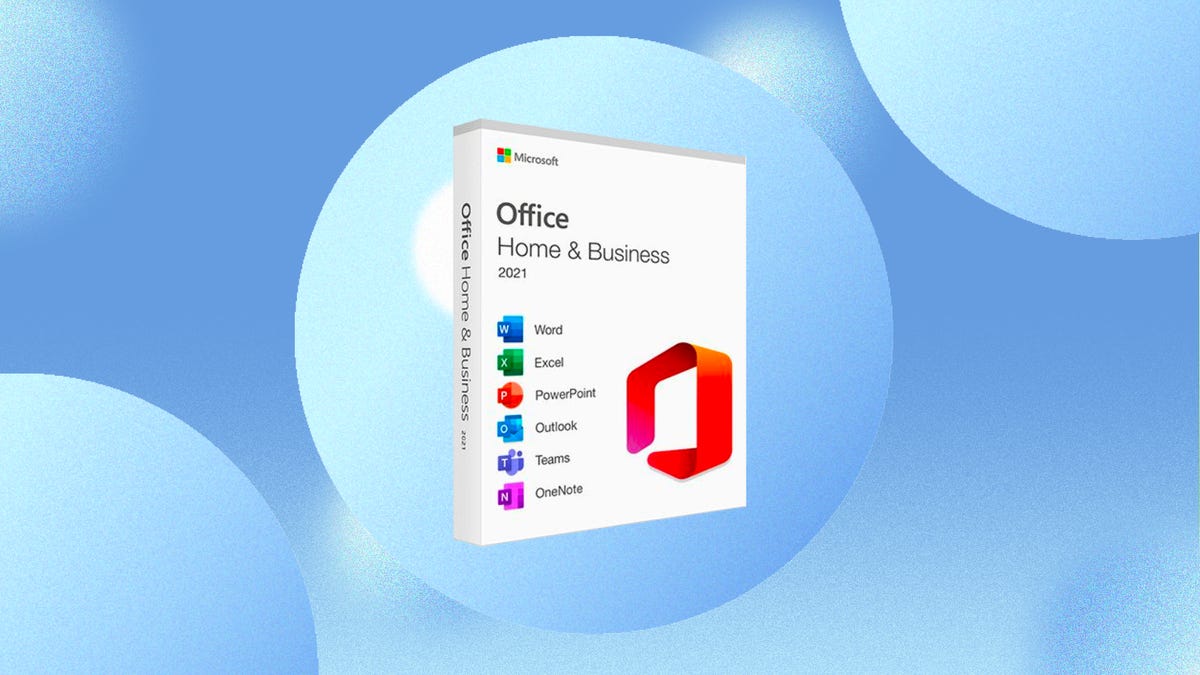Technologies
This Popular Microsoft Office 2021 Lifetime License Deal Is Back on Sale at $40
Avoid paying monthly fees for Microsoft’s Office apps with this one-time deal.

Microsoft’s Office suite of apps offers industry-standard productivity tools and an essential part of any computer user’s arsenal. It’s used by businesses, schools and individuals around the world, and for word processing, spreadsheets, mail and more, it’s probably an Office app you’re going to want to use. You’ve probably used Word, Excel, PowerPoint and Outlook before, but Office apps aren’t always included with computer purchases, and getting access on your own can carry a hefty price tag.
There is a barebones freebie version of Office out there, but assuming that basic version of Office won’t work for you (see below), your options essentially come down to paying a rolling monthly or yearly fee for a Microsoft 365 subscription or opting instead for a one-time Office license with the full panoply of apps, which typically costs as much as $430. But for a limited time, StackSocial is offering a Microsoft Office 2021 license for just $40. That’s over 80% off its usual price. Better yet, this license, which is available for either Windows or Mac, is a one-time purchase that grants you unlimited access with no recurring charges.

StackSocial’s deal is a great bargain when compared with the online Microsoft 365 subscription suite that starts at $7 a month or $70 a year for individuals. There’s a free online version of Microsoft Office that you can use as well, but it isn’t nearly as feature complete. (Separately — and notably — Apple users should note that Outlook is now a free app for the Mac.)
Now, a deal this good comes with some caveats. First, this key is good only for a single computer, so you won’t be able to install it on various machines in your home, and if your current computer happens to die, you could run into a snag when trying to transfer it. Likewise, you’re passing up on other benefits you’d get as a 365 subscriber. You won’t get any OneDrive Cloud Storage, nor will you get the fancy new cloud-based AI features like Microsoft Copilot. And while the apps should continue to work as long as your computer does, Microsoft’s support for this version of Office ends on Oct. 13, 2026.
To that last point: Though this is listed as a «lifetime license» — that is, the lifetime of the computer you installed it on — it’s worth noting there’s always a risk that Microsoft could terminate the license. But versions of Stack’s deal have been running for more than a year — the one we bought in early 2022, for instance, still works fine. At this cost, it takes a little over four months for you to get a full return on the investment compared with buying the subscription, so the risk factor isn’t super high here.
Technologies
We’ve Found the Coolest, Most Futuristic Tech at CES 2026. And the Show Just Started
We’ve already had a day to trawl for our favorite cutting-edge technology. Neat stuff abounds!

We have people all over the show floor and beyond at CES, searching for the most interesting, innovative and cutting-edge tech available. A ton of useful new information is also available, which you can find on our CES 2026 live blog and in our CES hub.
The show floor opened Tuesday, and we had a lot of preview time beforehand to gawk at some CES staples, such as robots, electronic toys, phones and more. I’ll be back here to top off our fun finds regularly throughout the show.
Technologies
Grab This Tariff-Busting Xbox Series X Deal and Save $44 While You Can
You can bag a 1TB Xbox Series X for just $606, but act fast, since we don’t know how long this deal will last.

Ever since tariffs and other economic uncertainty led to Xbox price increases in late 2025, things have gotten expensive. A 1TB Xbox Series X now sells for $50 more than it used to, and there is little sign of these prices improving anytime soon.
Thankfully, every so often, a deal pops up that helps make things a little more affordable like this Walmart discount that slashes that same Series X to just $606. The catch? Well, there isn’t one. But we don’t expect this deal to last for long, so make sure to get your order in soon before it leaves for good.
The Xbox Series X has been around for a while now, so there are no surprises with what you get in the box. The Series X comes with a 1TB SSD for storage, and you get a controller in the box. This version also has a disc drive for installing games and watching Blu-ray movies, too.
Hey, did you know? CNET Deals texts are free, easy and save you money.
You can look forward to watching 4K content and playing 4K games, as well as enjoying audio options such as Dolby Digital, Dolby TrueHD and DTS. All of that makes this a capable machine, whether you want to watch content or play games.
CHEAP GAMING LAPTOP DEALS OF THE WEEK
Why this deal matters
It’s unlikely that Xbox prices will get any cheaper anytime soon, so deals like this are the best we can expect for a while now. If you’re in the market for an Xbox and have the $604 to spare, then this is probably the time to place your order before it’s too late.
Technologies
Dreaming of a Cable-Free World? I Think I Just Saw the Future of Wireless Power
This is the coolest thing I’ve seen at CES 2026. And it has nothing to do with AI.

Many technology companies arrive at CES 2026 in Las Vegas, the world’s biggest tech show. They often make bold claims about the life-changing potential of their innovations, but it’s rare to see anything that actually lives up to the hype.
When you do see something truly special, on the other hand, it can seem like magic. That’s exactly how I felt when I experienced the wireless charging demo from Finnish company Willo, a deep-tech startup that’s just emerged from stealth mode.
«Seeing is believing,» Willo co-founder and President Marko Voutilainen tells me as I take a seat in a Las Vegas hotel suite to witness what the company hopes will be a revolution in wireless power. It could render the charging cables that rule our lives and clog up our drawers obsolete for good.
Wireless power has long posed a conundrum to tech companies. There needs to be perfect alignment between a device and the charger, which means that it’s often just as convenient to simply plug a cable into your phone. Wireless charging today feels like a half-baked solution.
The tech that Willo showed me doesn’t rely on charging pads, line of sight, directional targeting or even immediate proximity. Instead, it allows devices to be charged simply by existing within the force field of the power source.
The demo I’m being shown looks unassuming. They tell me I shouldn’t get caught up too much with the form factor of the power source — a simple gray-white cube. This isn’t a consumer device that’s for sale, merely a means to demonstrate the technology to me.
Willo CEO Hari Santamala picks up several receivers, black boxes shaped like phones with LEDs on the top. As he moves them to within 15 inches or so of the power source, the LEDs light up. He moves them around the cube, rotating them in different directions. The LEDs remain lit.
I’m seeing. I’m believing.
Making power cables the floppy disks of tomorrow
Unfortunately, I’m not allowed to take any pictures or videos. This week at CES, Willo is emerging from stealth mode to show the world what it can do, but it’s still playing its cards close to its chest.
The core technology is based on more than a decade of research by the company co-founder and CTO Nam Ha-Van. The company is claiming a number of world firsts with its wireless power tech, including the ability to rotate devices at any angle while charging, along with the ability to charge multiple devices at once.
Santamala talks me through his vision for how it would exist in the home. «You have to build the transmitter in a way that it’s kind of a natural part of your environment,» he says. «Ideally, we don’t see any of this,» he adds, gesturing to the cube.
You could sit on the sofa with your phone in your pocket, and it would be quietly charging while you watch TV. If you were working from home, you could move freely around your house with your laptop, never having to worry about plugging it in.
«We want to do to power cables, what floppy disks are to us today,» Voutilainen says. «They’re remnants of the past.»
It feels like the thing we’ve been waiting for — the way wireless charging was always supposed to be. So when can we expect to get it?
Willo is here at CES meeting journalists like me, but also the kind of partners it will need to adopt this technology and take it out into the world. Voutilainen and Santamala are cagey about their ideal strategy for doing this, but it feels like they’re hinting towards something open and large-scale. Comparisons to Wi-Fi and Bluetooth are thrown around.
«This can really change our everyday lives if introduced correctly in a very kind of open and driving-the-market-forward kind of way,» Santamala says. The company’s tech is «pretty ready» for industrialization, he adds — it just depends on their partners’ use cases and timelines.
I depart from the demo suite, hoping that what I’ve seen is as viable as I’ve been led to believe. Willo clearly thinks it has something special on its hands, and if the rest of the tech industry agrees, this might just be the first step toward a future free of charging cable fuss and inconvenience.
-

 Technologies3 года ago
Technologies3 года agoTech Companies Need to Be Held Accountable for Security, Experts Say
-

 Technologies3 года ago
Technologies3 года agoBest Handheld Game Console in 2023
-

 Technologies3 года ago
Technologies3 года agoTighten Up Your VR Game With the Best Head Straps for Quest 2
-

 Technologies4 года ago
Technologies4 года agoBlack Friday 2021: The best deals on TVs, headphones, kitchenware, and more
-

 Technologies4 года ago
Technologies4 года agoGoogle to require vaccinations as Silicon Valley rethinks return-to-office policies
-

 Technologies4 года ago
Technologies4 года agoVerum, Wickr and Threema: next generation secured messengers
-

 Technologies4 года ago
Technologies4 года agoOlivia Harlan Dekker for Verum Messenger
-

 Technologies4 года ago
Technologies4 года agoiPhone 13 event: How to watch Apple’s big announcement tomorrow
